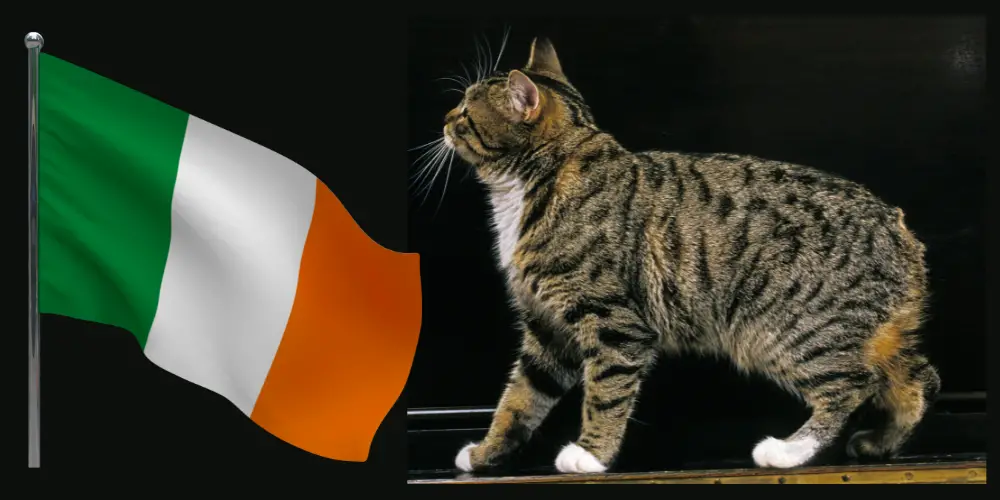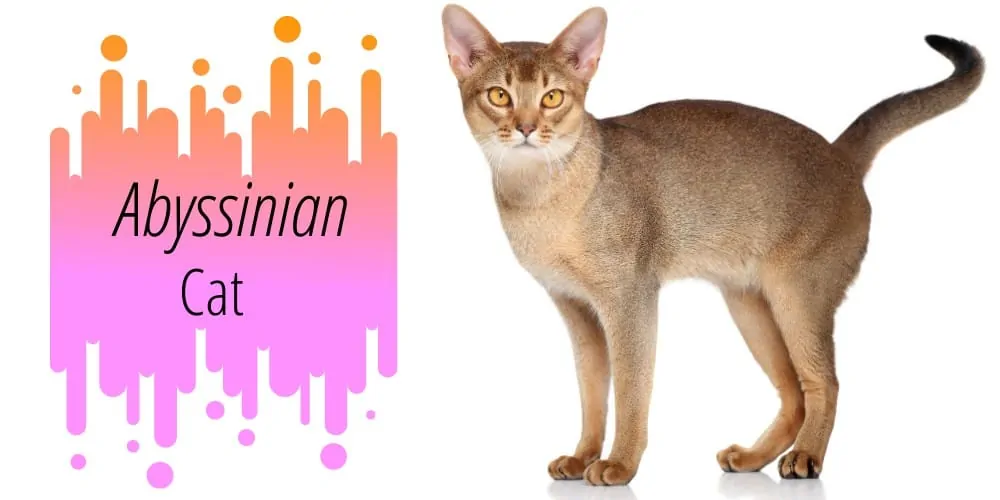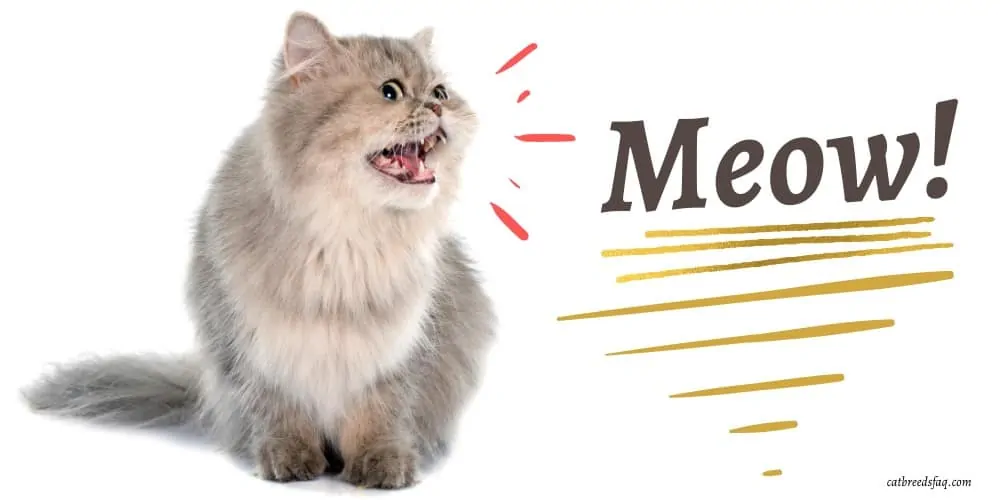Have you ever heard of a tailless cat from Ireland? If not, you’re in for a delightful surprise!
The Manx stands out as a unique feline wonder among the various Irish cat breeds.
This tailless treasure is a curiosity and a symbol of Ireland’s rich cultural heritage.
This post is tailored for cat lovers curious about Irish cat breeds, especially those enchanted by the mysterious Manx.
So, let’s embark on this feline adventure and unravel the tailless mystery of the Emerald Isle!
Key Takeaways
- The article introduces the tailless Manx cat as a unique and symbolic breed from Ireland.
- Various features of the Manx, including its tailless nature, colors, and patterns, are explored.
- Four types of Manx cats are described: Cymric, Isle of Man Longhair, Isle of Man Shorthair, and Tasman Manx.
- The Manx’s appearance, personality, coat, and history are detailed in a comprehensive overview.
- The cultural significance of the Manx in Irish legends and folklore is examined.
- Practical advice on caring for a Manx includes grooming, health considerations, and finding the right fit.
- The Manx’s role in Irish heritage is celebrated through cat shows, cultural festivals, merchandise, education, social media, and tourism.
The Manx Cat – Ireland’s Feline Treasure
Breed Overview
The Manx cat, hailing from the Isle of Man, is a breed like no other. Its most distinctive feature, the absence or shortening of a tail, results from a natural genetic mutation.
But there’s more to the Manx than just its tail (or lack thereof):
Appearance
Muscular and compact, the Manx cat boasts a rounded head and large, expressive eyes.
Its hind legs are notably longer than the front ones, giving it a unique stance. The absence of a tail, or sometimes just a stub, adds to its distinctive appearance.
Personality
Known for their intelligence and playful nature, Manx cats are often described as “dog-like” in their loyalty and affection.
They are social and enjoy being part of the family activities. Their playful antics and loving nature make them wonderful companions.
Coat
Available in both short and long-haired varieties, the Manx’s coat can be found in a wide array of colors and patterns.
The short-haired Manx has a dense and plush coat, while the long-haired variety, known as the Cymric, has a silky and flowing coat.
History
The Manx’s origins are shrouded in mystery, with legends linking them to various historical figures and events.
Some believe that Viking settlers brought the breed to the Isle of Man. Others tell tales of the Manx being a favored pet of royalty.
The lack of a tail has even led to myths that the Manx was a product of a rabbit and cat union!
Health Considerations
While generally robust, the same gene that causes the Manx’s taillessness can sometimes lead to health issues. Responsible breeding practices are essential to minimize these risks.
Care and Maintenance
Manx cats require regular grooming, especially the long-haired variety. Their playful nature means they also benefit from regular play and mental stimulation.
The Manx cat’s unique characteristics, from its appearance to its history, make it a fascinating and endearing breed.
Whether you’re a cat lover or intrigued by Irish cat breeds, the Manx offers a captivating glimpse into the world of feline diversity.
Four Types of Manx Cats
The Manx cat breed is diverse, with four distinct types that cater to different preferences and lifestyles.
Each type has its unique characteristics, adding to the allure of this fascinating breed:
1. Cymric
The Cymric is the long-haired version of the Manx. With a lush and silky coat that can come in various colors and patterns, the Cymric is known for its beauty and elegance.
Despite its luxurious appearance, the Cymric is playful and affectionate, making it a wonderful family pet.
2. Isle of Man ( Longhair )
Like the Cymric, the Isle of Man Longhair boasts a long, flowing coat. What sets it apart are specific breed standards and characteristics that differentiate it from the Cymric.
Often considered a separate breed, the Isle of Man Longhair shares the same tailless feature but may have body shape and personality variations.
3. Isle of Man ( Shorthair )
The Isle of Man Shorthair is the short-haired counterpart of the Manx. With a dense and plush coat, this type offers the same tailless wonder but with less grooming needs.
The Isle of Man Shorthair is known for its friendly nature and adaptability, making it suitable for various living environments.
4. Tasman Manx
A rare variety with unique traits, the Tasman Manx is a recent addition to the Manx family.
Originating from New Zealand, the Tasman Manx has specific features that set it apart, including variations in tail length and body structure.
Its rarity and distinct appearance make it a sought-after choice for enthusiasts and collectors.
These four types of Manx cats offer a range of options for cat lovers, each with charm and appeal.
From the luxurious Cymric to the rare Tasman Manx, the diversity within the Manx breed reflects the richness and complexity of Irish cat breeds.
What Makes the Manx Unique?
The Manx cat is a true marvel of nature, most famous for its tailless feature. But that’s not all!
These cats come in various colors and patterns, ranging from solid shades to striking bi-colors.
Did you know some Manx cats have a small tail stub while others have none?
Their playful and affectionate nature adds to their charm, making them a beloved pet in many households.
The Manx in Irish Culture and Folklore
The Manx cat isn’t just a unique breed; it’s a symbol of Irish culture and folklore.
Its tailless appearance and mysterious origins have given rise to numerous legends and tales, weaving it into the fabric of Irish tradition.
Legends and Folktales
Can you imagine a cat turning a spit over a fire?
That’s one of the many tales associated with the Manx! Some stories depict the Manx as a mystical creature with supernatural abilities, while others celebrate it as a symbol of good fortune.
From being considered good luck charms to protectors of homes, the Manx has played various roles in Irish society.
Sailors often kept a Manx on board their ships, believing it would protect them from storms and bring good luck on their voyages.
Historical Connections
Some even believe that the Manx was brought to Ireland by Norse settlers during their invasions in the 8th and 9th centuries.
The breed’s connection to Viking lore adds another layer of intrigue to its already captivating story.
Cultural Significance
These stories and historical connections add a mystical allure to the breed, making it more than just a pet but a part of Ireland’s cultural identity.
The Manx has been featured in literature, art, and music, reflecting its deep-rooted connection to Irish heritage.
Whether it’s a symbol of protection, a talisman for good luck, or a beloved companion, the Manx cat holds a special place in the hearts and minds of the Irish people.
Its unique features and rich folklore continue to fascinate and inspire, making the Manx a true treasure of the Emerald Isle.
Owning a Manx – Tips for Cat Lovers
Care and Grooming
Owning a Manx is a joy, but it also comes with responsibilities. Their unique physique requires special attention to grooming and care:
- Brushing: Regular brushing is essential to keep the coat healthy, especially for long-haired varieties like the Cymric. A weekly brush for short-haired and bi-weekly for long-haired should suffice.
- Diet: A proper diet that meets the nutritional needs of the Manx is vital. Consult a veterinarian to choose the right food for your cat’s age, weight, and activity level.
- Exercise: Manx cats are playful and energetic. Interactive toys, climbing structures, and regular playtime will keep them happy and fit.
- Health Check-ups: Routine veterinary check-ups are essential to monitor the overall health of your Manx and catch any potential issues early.
- Dental Care: Regular dental check-ups and at-home care can prevent dental issues.
- Nail Trimming: Regular nail trimming helps keep the Manx comfortable and prevents overgrowth.
Health Considerations
While generally healthy, Manx cats can have specific health issues related to their tailless nature:
- Spinal Problems: The gene that causes the tailless feature can sometimes lead to spinal issues. Awareness of any signs of discomfort or mobility issues is essential.
- Arthritis: Regular check-ups can help detect and manage arthritis, particularly in older Manx cats.
- Digestive Issues: Some Manx cats may be prone to digestive problems. A proper diet and regular veterinary care can mitigate these issues.
- Heart Health: Regular veterinary examinations can help monitor and maintain heart health.
- Genetic Testing: If purchasing a Manx from a breeder, inquire about genetic testing to ensure the cat doesn’t carry genes for specific health problems.
Regular veterinary care, awareness of potential problems, and a loving and attentive approach to care are key to ensuring your Manx’s happy and healthy life.
Finding a Manx
Are you interested in adopting or purchasing a Manx?
Finding the right Manx cat requires careful consideration and research. Here’s a step-by-step guide to help you find the perfect feline friend:
Research Reputable Sources
- Breeders: If you want to purchase a Manx, research reputable breeders who specialize in the breed. Look for breeders who prioritize health, temperament, and ethical breeding practices.
- Rescue Organizations: For those interested in adoption, many rescue organizations and shelters have Manx cats looking for loving homes. Some organizations specialize in specific breeds, including the Manx.
Ask Questions
- Health: Inquire about the cat’s health history, vaccinations, and known health issues.
- Temperament: Ask about the cat’s personality and behavior to ensure it aligns with your lifestyle and family dynamics.
- Breed Information: If you’re new to the Manx breed, don’t hesitate to ask questions about care, grooming, and breed-specific considerations.
Visit in Person
- Meet the Cat: If possible, visit the breeder or rescue organization to meet the Manx cat in person. Spend time interacting to gauge compatibility.
- Assess the Environment: Pay attention to the living conditions, cleanliness, and overall environment where the cats are kept.
Consider Adoption
- Adoption Benefits: Adopting a Manx from a shelter or rescue organization can be a rewarding experience. Many wonderful cats await loving homes, and adoption supports animal welfare efforts.
Share Your Experience
- Join the Community: If you own a Manx, why not share your experiences in the comments? Your insights can be valuable to others considering this unique breed.
Celebrating Irish Cat Breeds
The Manx is more than just a breed; it celebrates Irish heritage.
Its unique tailless feature, playful nature, and rich history have made it a symbol of pride and fascination in Ireland and beyond.
Here’s how the Manx is honored and cherished:
Cat Shows and Competitions
The Manx’s distinctive appearance and charming personality make it a favorite in cat shows and competitions.
From local events to international stages, the Manx has been a showstopper, winning hearts and accolades.
Cultural Festivals
In Ireland, the Manx is often featured in cultural festivals and celebrations.
Its connection to Irish folklore and heritage makes it a fitting representative of the country’s rich traditions.
From art to literature, the Manx has found its way into various expressions of Irish culture.
Manx-Themed Merchandise
The allure of the Manx has inspired a range of merchandise, from artwork to clothing.
These items celebrate the breed’s uniqueness and offer cat lovers a way to express their admiration for the Manx.
Educational Programs
Schools, museums, and educational institutions in Ireland and other countries have included the Manx in their programs to teach about genetics, history, and cultural diversity.
The breed’s unique genetic trait offers a fascinating entry point into scientific exploration.
Social Media and Online Communities
Online platforms have allowed Manx enthusiasts to connect, share experiences, and celebrate the breed.
Social media pages, blogs, and forums dedicated to the Manx provide a virtual space for admiration and learning.
Tourism and Travel
The Isle of Man, the birthplace of the Manx, has embraced the breed as part of its tourism appeal.
Visitors can explore the history of the Manx through museums, historical sites, and even themed tours.
The celebration of the Manx cat goes beyond mere ownership; it’s a multifaceted appreciation that spans various aspects of life.
From cat shows to cultural festivals, the Manx’s unique appearance and charming personality invite cat lovers and cultural enthusiasts to explore and celebrate this extraordinary breed.
The Manx is not just a cat; it’s a living testament to the diversity and richness of Irish cat breeds, a feline treasure that continues to captivate and inspire.
Conclusion
From its tailless wonder to its cultural significance, the Manx cat is a fascinating exploration of Irish cat breeds.
Whether you’re a cat lover or simply curious about the Emerald Isle’s feline treasures, this guide offers a comprehensive look into the world of the Manx.
So why not comment, share the post, or explore more about Irish cat breeds?
The tailless mystery of the Emerald Isle awaits you!
REFERENCES:
Manx cat. (2023, August 6). In Wikipedia. https://en.wikipedia.org/wiki/Manx_cat


